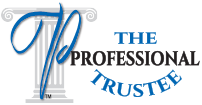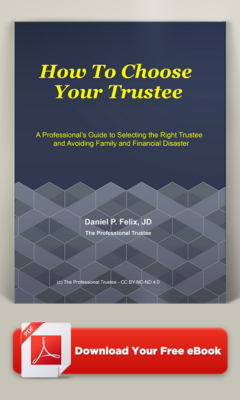Offer this proven practice to help your clients enjoy a smooth transition and avoid litigation and other horrors
Executive Summary
Part 1: Problem and Solution: Despite excellent drafting, families experience distress and worse around trust administration, because of a lack of clarity and consensus around what is desired and called for as well as from a lack of competence in execution. Field-Testing is a practical platform to allow the stakeholders to participate in their roles to see how the trust may play out in real life.
Part 2: How to Field-Test: Field-Testing is conducted through a live simulation, which can include the trust and estate attorney and other professionals. It can be conducted on multiple occasions including ever greater circles of stakeholders. Components can include:
- Family-generated scenarios over what they are concerned about.
- A written summary of important trust provisions.
- An independent facilitator.
Part 3: Case Study: Through role-play, the family-member fiduciaries found they were fit for only some of their key tasks, but not for others. This insight led to a redraft of the trust in order to bring in a different fiduciary solution to perform those tasks which the family members did not want to be responsible for.
PART 1: Field-Testing for Success — Problem and Solution
Test the trust while there is an opportunity to improve it
THE PROBLEM: Families suffer — and legal claims arise — out of trusts that don’t work as expected.
The fires of frustrated expectations are often fanned by non-expert and non-fitting fiduciaries. As a result, family relationships and businesses can all go up in smoke.
The story can go different ways, sometimes like this: The parents prepare estate plans. Maybe they have a brief discussion with the family member they choose to serve as fiduciaries: “Will you serve?” “OK.”
And so, all too often the chosen fiduciaries aren’t tested in their jobs until it’s too late to change anything. And they receive no training for this sensitive and technical position.
Further, the parents refuse to share the plan details with their other
children. “You’ll be taken care of,” they say. And so, there is no opportunity for setting expectations, or better, a meeting of the minds around the disposition of assets. No opportunity for adult collaborative discussions about what best serves the family.
Also significant: there’s no effort to develop the family’s ability to make decisions together or to contribute to the family story.
With disability and death of the parents comes high emotions, and often the release of pent-up feelings accumulated over a lifetime.
So too often the family finds itself with:
- No fiduciary or family training.
- No acceptance or consensus on asset distribution.
- No structure to create consensus.
- High and often unstable emotions.
And the fiduciaries are left in this hostile position to administer and defend the trust!
And the glue that held all together — the parents — are unavailable, so things fall apart. This is especially evident in blended families. Without the parent, the children often are less connected with the surviving spouse and her family.
It’s also the scenario where there is no system to replace the strong-willed business owner who had “run” the family.
It can go downhill horribly from there!
THE SOLUTION: Field-Test Process: The solution can be found by running contingency simulations. Test the trust while there is an opportunity to improve its odds for success.
First, test the trust with the key stakeholders: at least the trust maker and the fiduciaries. In playing out scenarios, look to see:
- Does it work?
- Does everyone understand their role and the situations they are likely to encounter?
- Does the arrangement still squarely address the challenges and wishes of the trust creator? If not, modify the trust.
Later, in a second field test, expand the test participants to include all of more of the trusted advisors or family members. Through discussion and test scenarios gauge the responses to those questions and more:
- Do all the stakeholders see eye-to-eye with each other?
- With the fiduciaries and with the family?
- Are they able to communicate and otherwise work well each other, or is there too much jockeying for position?
Consider performing a third simulation with a larger group.
- Are the parents and children able to begin to collaborate over building the future?
- Are their respective concerns and goals being addressed?
With this process, families can have greater confidence that the trust will better fit and can better enjoy a more positive legacy.
PART 2: Field Testing for Success — Details on “How To”
Use a separate, professional facilitator!
Here are some of the key consideration to the field-test process.
The field-test can begin with a written trust guide, that is, a summary of key provisions of the trust in lay terms. Particular attention should be given to the both the beneficiaries’ roles as well as the functioning of the fiduciaries: their responsibilities, limitations and criteria for decision-making. These should be shared with the fiduciaries as well as with the trust creator — and in due time, with the rest of the family. Collaboration benefits from everyone understanding the rules.
My practice is to create this document, which I call the Trust Guide, as part of standard client procedure.
Generally, the first field-test should involve the trust maker, the fiduciaries, and the trust and estate attorney. Consider including others particularly close, such as the trust creator’s spouse, the corporate attorney and perhaps others deeply connected with the transition of the business.
With this cast assembled — including a separate facilitator — cover a pre-arranged agenda including immersion in several carefully crafted scenarios, around key events, such as disability and death of the trust creator. He — and his significant other — may suggest some other scenarios based on what he is most concerned about. Take nothing for granted. Consider the places between the substantive; for example, the process of how the fiduciary is notified, assumes responsibilities and communicates with the stakeholders. See how the process and outcome of these scenarios compare with his expectations. Confirm also that the playing out will provide clarity as well as comfort to the family and the business.
The field-test may also include role play on how the fiduciary deals with the each scenario and then at least roughing a flow chart of consequences. Care should be given to expose the multiple tiers in which the fiduciary is working: addressing the substantive issues, coordinating with other fiduciaries and professionals, and communicating with family members, to name the big three.
The next part of the scenario is to practice how decisions will be made, especially where the various trust stakeholders have different, if not opposing wishes. A closely related, if separate part of decision-making, is communicating the process and the ultimate decision to the family and other stakeholders. While the decision may belong to one alone, that fiduciary may be well advised to gain acceptance from those who are effected by the decision — and who have the power to file a claim.
Time should be allowed in the field-test for all to ask questions and otherwise clarify likely facts as well as to explore the boundaries of both the law generally and the document specifically. This process should serve as a check against the wish list of the trust creator. The facilitator and others should be looking for substantive and other fit, and should provide a safe environment to allow all of the stakeholders to raise questions and concerns. These questions and concerns may be the signs to further improve the trust as designed, suggesting that modifications could be considered.
Following those modifications, the trust creator or one of the advisors can schedule a second field-test for an appropriate later time. The second field test should involve the same cast PLUS all the trusted advisors. This will give the trust creator confidence that the team works well together, and will help expose additional communication and governance issues.
And again, most importantly, this will allow the trust creator to confirm his expectations are understood, and that he understands their consequences. The facilitator should again work in advance of the actual field-test to make sure that the team is set up for success.
Following the resulting modifications, the third field-test cast is expanded to include the beneficiaries. The participation of troubled, troubling or incompetent beneficiaries should be considered on a case-by-case basis.
The separate facilitator adds the additional benefit of allowing better observation of how the family — and the advisors — are taking it in.
The goal is to not only give the trust creator confidence in the evolved plan and team, but also to help invest the family in that plan and team. The more invested the family, the more likely they’ll successfully get through the transition — and less likely to break apart or litigate.
Accomplishing that goal — enhancing family harmony and the execution of a successful plan while reducing risk — is a wonderful win-win result.
Part 3: Field-Test Case Study — Sister Fiduciaries Redux
Before: The trust creator is a divorced father of two adult children. Established a half dozen years before, his trust provides for his exclusive benefit while alive, and after death, to his children, to named charities and a few specific beneficiaries. He named his out-of-town sisters as disability and post-mortem trustees, and the estate planning attorney as trust protector to direct the trustees.
The motivation: The trust creator wanted to see how the trust would work, including that his sisters were up for the job.
The field-test: The simulation took place at a singe meeting. Present were: the trust creator, the two sisters, and the estate planner/trust protector and myself. Through experiential exercises and simulations, it became clear that the sisters were proficient and comfortable in dealing with distributions, but were not proficient and not comfortable in the other trust functions. There was some evidence to support the sisters as a trust protector role, though their geographic distance from their brother and his children may be more of an issue here.
The result: The trust creator is in the process of reconfiguring his trust. He intends to keep his sisters as distribution trustees, but replacing them as to the other trustee functions. This reallocation of responsibilities should greatly increase the effectiveness of the trust, as well as remove the burden on the sisters of tasks they would be ill-suited for and uncomfortable with.
A professional fiduciary will serve the remaining trustee functions. The estate planning attorney will continue to serve as trust protector with his duties modified. As to the distribution trustees, the trust protector has the authority to replace them, but only if both should pre-decease their brother. In the event of malfeasance, he may terminate their role. As to the other trustee, the trust protector will have additional responsibilities to monitor and to approve fees.
A repeat simulation is intended, and depending on how that one goes, the following simulation will include the beneficiaries.
© 2008 – 2024 Daniel P. Felix, all rights reserved.


